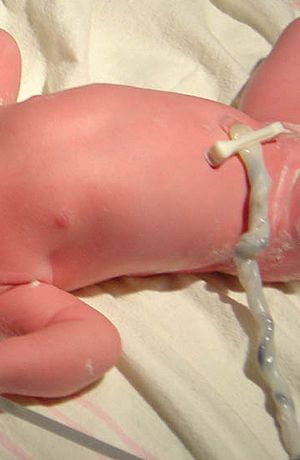Umbilical cord facts for kids
The umbilical cord is a special tube that connects a growing baby inside its mother to the mother's body. It's like a lifeline, making sure the baby gets everything it needs to grow strong and healthy, such as oxygen and food. It also helps remove waste products from the baby.
Contents
What is the Umbilical Cord?
The umbilical cord is a flexible tube that forms during pregnancy. It links the developing baby to the placenta, which is an organ that grows in the mother's uterus. The placenta acts like a filter and a delivery system, passing nutrients and oxygen from the mother's blood to the baby.
What is Inside the Cord?
The umbilical cord is made of a few important parts:
- Two arteries: These carry blood with waste products and carbon dioxide away from the baby and back to the placenta.
- One vein: This carries fresh, oxygen-rich blood and nutrients from the placenta to the baby.
- Wharton's jelly: This is a special, jelly-like substance that surrounds the blood vessels. It protects them and keeps them from getting squashed or tangled.
The cord is quite strong and flexible, allowing the baby to move around freely inside the womb without damaging its lifeline.
How Does the Cord Help the Baby?
Before a baby is born, it cannot breathe air or eat food on its own. The umbilical cord solves this problem!
- Oxygen delivery: The vein in the cord brings oxygen from the mother's blood to the baby's blood.
- Nutrient supply: All the food and vitamins the baby needs for growth also travel through the vein.
- Waste removal: The arteries in the cord carry waste products, like carbon dioxide, from the baby's blood back to the placenta. The mother's body then gets rid of these wastes.
This amazing system works perfectly until the baby is ready to be born.
What Happens at Birth?
When a baby is born, the umbilical cord is no longer needed. The baby can now breathe air and will soon start to feed on its own.
Clamping and Cutting the Cord
Right after birth, the doctor or midwife will clamp the umbilical cord in two places, usually a few inches from the baby's belly button. Then, they will cut the cord between the two clamps. This process is quick and painless for both the mother and the baby because there are no nerves in the cord.
The Umbilical Stump
After the cord is cut, a small piece of it, called the umbilical stump, is left attached to the baby's belly button. This stump is usually about 1 to 2 inches long. It will dry up and fall off on its own within 1 to 3 weeks after birth.
Caring for the Stump
It's important to keep the umbilical stump clean and dry to help it heal properly and prevent infection.
- Keep the area around the stump clean with mild soap and water, or as advised by a doctor.
- Allow air to get to the stump by folding down the top of the baby's diaper.
- Avoid giving the baby a full bath until the stump has fallen off. Sponge baths are best.
- Never try to pull the stump off, even if it looks like it's barely hanging on. Let it fall off naturally.
Once the stump falls off, the belly button (or navel) is left behind. This is a permanent reminder of the amazing connection the baby had with its mother before birth!
Images for kids
See also
 In Spanish: Cordón umbilical para niños
In Spanish: Cordón umbilical para niños







